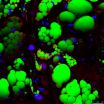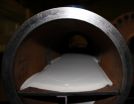In a poster presentation (Abstract #4053), Jane Little, MD, and colleagues presented promising findings related to a novel biochip aimed at improving outcomes for patients with sickle cell disease. Although it is well-known that red cell interactions are important in sickle cell disease, the technology to date has not allowed physician-scientists to evaluate these properties on a large scale basis. This innovative biochip, which evaluates the biophysical properties of red blood cells in sickle cell patients, has the potential to become a standard test for monitoring the disease because of its widespread applicability and its use of only small volumes of blood.
"This new technology gives us a better understanding of the disease and provides us with an important new tool to enhance the monitoring and medical management of patients with sickle cell," says Dr. Little, Director of the Adult Sickle Cell Anemia Center, UH Case Medical Center and Associate Professor at the School of Medicine. "If we can begin to identify and predict when patients will have flare-ups in their disease, we can avoid complications by more effectively treating them before their symptoms worsen."
Sickle cell disease is an inherited blood disorder that affects about three million people worldwide with an estimated 100,000 in the United States and causes pain crises, widespread organ damage and early mortality.
With just a few drops of blood, the biochip examines the biophysical properties of red blood cells, which in sickle cell patients crystalize to cause stiffness and cell deformity. The research team used the technology to examine surplus blood samples and found that sickle cell patients had alterations in the biophysical properties of their red blood cells compared to individuals without the disease.
Based on these findings, the research team has just opened a new clinical trial for 100 adult and pediatric patients. The follow-up study is aimed at correlating the cellular adhesion measurements with patient outcomes such as pain crises.
The biochip was developed by Umut Gurkan, PhD, assistant professor of mechanical and aerospace engineering at Case Western Reserve working in collaboration with a team of researchers, including Dr. Little who is also a member of the Case Comprehensive Cancer Center at Case Western Reserve. Co-investigators of the abstract also include Dr. Gurkan, Yunus Alapan and Kayla E. Gray.
The research was supported by a Doris Duke Foundation grant to Case Western Reserve as well as a Belcher-Weir Innovation grant from UH Rainbow Babies & Children's Hospital to apply the technology to pediatric patients.
Additional UH Seidman Cancer Center/ School of Medicine poster presentations
Viral Insertion Safety in Patients with Glioblastoma Who Received a Novel Lentiviral MGMT-P140K Gene Therapy to Protect Bone Marrow from Chemotherapy: No Dominant Clonal Evolution Observed with Chemo-Selection Author: Stanton Gerson, MD, Director, UH Seidman Cancer Center, Case Comprehensive Cancer Center at Case Western Reserve Abstract #4801: Monday, December 8, 2014, 6 PM - 8 PM
This phase one study examined gene therapy to protect healthy bone marrow from chemotherapy in patients with glioblastoma. Many patients with glioblastoma do not benefit from standard therapy. Treatment for glioblastoma generally begins with a surgical resection, followed by radiation therapy and chemotherapy to destroy remaining cancer cells, but the tumors can become resistant to this treatment.
Researchers developed a novel strategy to protect normal bone marrow from chemotherapy by adding a strong DNA repair protein, MGMT, to the stem cells. The addition of MGMT has been shown to make the tumor more responsive to treatment, and the study has been approved to move forward to phase two.
Phase I Trial of the Base - Excision Repair Blocker Methoxyamine (TRC-102) Combined with Fludarabine in Relapsed/Refractory Chronic Lymphocytic Leukemia (CLL) and Lymphoid Malignancies Author: Paolo Caimi, MD, Hematologist and Oncologist at UH Case Medical Center and Assistant Professor at Case Western Reserve University School of Medicine, member, Case Comprehensive Cancer Center Abstract #4688: Monday, December 8, 2014, 6 PM - 8 PM
This study was conducted to determine the maximum tolerated dose and dose limiting toxicities (DLT) of methoxyamine combined with fludarabine for patients with chronic lymphocytic leukemia (CLL) and lymphoid malignancies.
The phase one trial proved that using methoxyamine combined with fludarabine can cause permanent damage to cancer cells without damaging normal cells and is well tolerated, with no dose limiting toxicities observed. In turn, this provides a better quality of life among patients with no major complications resulting from treatment. Future studies are planned and have been approved to move forward to phase two.
INFORMATION:
About University Hospitals
University Hospitals, the second largest employer in Northeast Ohio with 25,000 employees, serves the needs of patients through an integrated network of 15 hospitals, 28 outpatient health centers and primary care physician offices in 15 counties. At the core of our $3.5 billion health system is University Hospitals Case Medical Center, ranked among America's 50 best hospitals by U.S. News & World Report in all 12 methodology-ranked specialties. The primary affiliate of Case Western Reserve University School of Medicine, UH Case Medical Center is home to some of the most prestigious clinical and research centers of excellence in the nation, including cancer, pediatrics, women's health, orthopaedics, radiology, neuroscience, cardiology and cardiovascular surgery, digestive health, transplantation and genetics. Its main campus includes UH Rainbow Babies & Children's Hospital, ranked among the top children's hospitals in the nation; UH MacDonald Women's Hospital, Ohio's only hospital for women; and UH Seidman Cancer Center, part of the NCI-designated Case Comprehensive Cancer Center at Case Western Reserve University. For more information, go to http://www.uhhospitals.org






